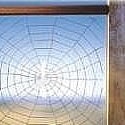Explore the Northern Cardinal Nesting, Egg Laying, and, Feeding Habits
These birds are frequent year-round visitors to bird feeders, especially those offering protein-rich black-oil sunflower seeds.
Identifying: Size - Field Marks
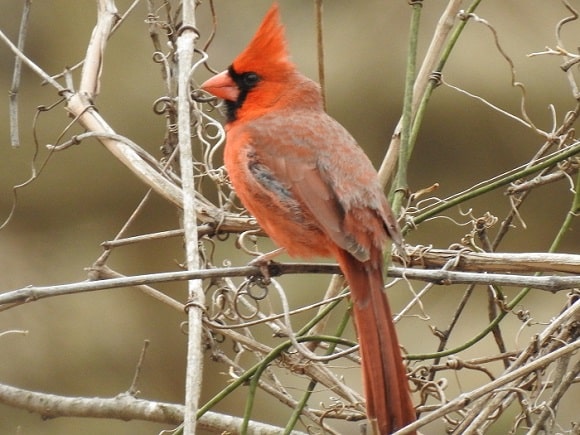
Measuring 8 1/2 inches long, the male is a bright red bird with a pointed crest on the top of his head.
Both have small black masks on their faces that surround the bill and eyes with the male's more pronounced.
Female Northern Cardinals have a distinctive appearance that is different from their male counterparts.
They have a reddish-brown or rusty-colored body, with a crest on their head like the males.
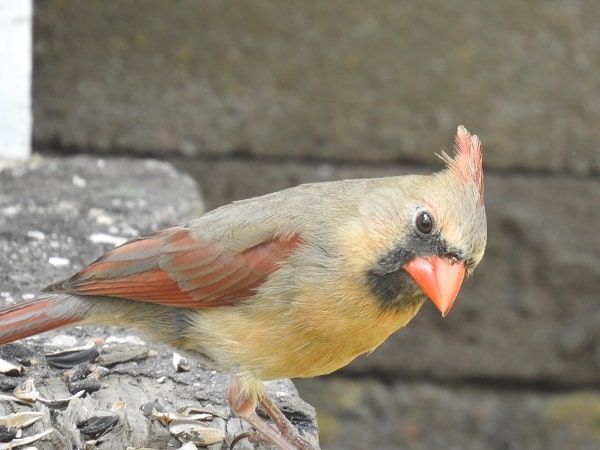
However, unlike males, the female cardinal lacks the bright red plumage, and instead has a muted red color on the crest, wings, and tail.
Northern Cardinals have been expanding their range north while also inching their way westward.
One explanation for the Cardinals' move northward is a proliferation of more people feeding birds.
Northern Cardinals are permanent residents throughout their range.
Nesting Habits
The mating - breeding season of the Northern Cardinal can begin as early as late March with second nests starting 2 to 3 weeks after the first fledge.
By August, Northern Cardinals will have stopped nesting for the season.
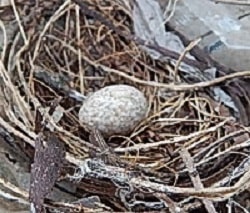
Most females Cardinals will begin laying eggs in April. She will lay 2-5 eggs that are buff-white in color and have dark marks.
The female builds the nest while the male keeps a close eye on her and the surrounding territory for predators and other males.
The nest is made up of twigs, bark strips, vine leaves, rootlets, and paper lined with vines, grass, and hair.
Where Do They Nest?
Cardinals nest in a variety of locations. Early in the season they are more likely to build nest in small evergreen trees or shrubs that provide better shelter in cooler weather.
In early summer around the month of June, second broods are raised. These nest sites can be found in deciduous shrubs or small trees where they're shaded from hot weather.
Cardinals prefer to build their nests 1-15 feet above the ground.
They do not use bird houses, but have been seen nesting on abandoned feeders and other ledges that provide some overhead cover.
Below is video of a Cardinal nesting in a cedar tree that we live-streamed one season.
The female is the only one to incubate the eggs. Birds don't have a gestation period. The time from egg laying to hatching is called incubation.
Egg laying may begin 1 to 8 days after nest completion. Incubation begins after the last egg is laid.
| Northern Cardinal Nesting Habits | |
|---|---|
| Eggs | 1 - 5 Avg. 3 |
| Incubation | 12 - 13 days |
| Nestling Phase | 9- 11 days |
| Broods | 2 - 3 |
Egg Laying
Females Cardinals will lay 1 egg each day for a clutch size of 1 to 5 eggs, with 3 eggs being average.
The female may sit for short periods before the last egg is laid, but come and go more frequently.
The males' duty during this time is to feed her on the nest and protect their territory from intruders.
Watching and listening closely, you'll hear the male call and the female will leave the nest to be fed by the male.
This can be a dangerous time since the eggs or young are left alone.
Incubation, Hatching, Fledging
The female will be the one to incubate the eggs. Cardinal eggs take about 12 to 13 days of incubation before they hatch into baby cardinals.
Once the Cardinal babies hatch, both males and females will feed the young. Baby Cardinals are featherless at first and will develop gray and red feathers like females.
The baby Cardinals will leave the nest in 9-11 days after hatching. Often the young are unable to fly much the first day or two after fledging.
Mating, Courtship Habits
One of the mating rituals of Cardinals can be seen at your bird feeder. It's called "mate feeding".
What you'll see is the male picking up a seed, hopping over to the female, and the two touch beaks "kiss" as she takes the food.
Mate-feeding continues through the egg-laying and incubation phases of breeding.
This mate-feeding, is a common type of courtship behavior with many of our backyard birds.
The video above shows an example of a male Cardinal offering food to the female while she is incubating the eggs in the nest.
Mate feeding is thought to be part of the pair bonding process.
This may serve as an example to the female how well the male will provide food to their young.
Do They Mate For Life?
Most Cardinal pairs mate for life and will remain together the whole year. In winter, the bond may be relaxed as they look for feeding areas.
Should one of the pair die, the surviving mate will bond with another at the beginning of the next breeding season.
Mating for life is often used in field guides to describe this behavior.
What Does Their Nest Look Like?
The female Cardinal builds the nest which takes about two weeks to complete. The nest is cup-shaped and measures about 3 to 4 inches in diameter.
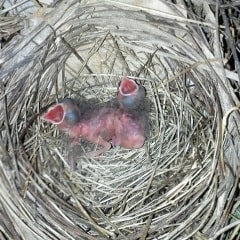
Nest Materials Used
The female Cardinal uses twigs, grasses, and other plant materials for the outside. She lines the inside with soft materials, such as grasses, leaves, and feathers.
I've seen man-made materials such as pieces of cellophane woven in the outside of the nest.
How Can I Identify a Fledgling Cardinal
In the video below, you can see what a baby Cardinal looks like just before leaving the nest. Doesn't look much like the red bird it will become.
They are quite small with very short tales and look nothing like their parents.
Baby Cardinals grow quickly and within a week from leaving the nest, they'll be close to adult size and look similar to females having gray or black beaks.
Do They Re-use the Nest?
Female Cardinals will construct a new nest for each brood and will not re-use a nest.
How Many Times Each Season Do They Lay Eggs
Cardinals attempt to lay eggs 2 - 3 times each season. Sometimes 3 different nesting attempts may be tried. Third attempts at laying may be due to failure of a nest.
The male continues to feed the first set of young for up to two weeks after leaving the nest. During this time, the female will be incubating her second clutch of eggs.
This will keep the male busy by continuing to feed the female, the first brood, and still protecting their territory.
Any males born this season will initially look like the female but by winter they will have the adult male plumage.
Should I Remove Old Nest?
Cardinals won't reuse a nest however, studies show that having more nests may reduce predation.
Cardinals often nest near the previous nest, so leaving the nest might offer some help concerning predation.
Citation - Watts, B. D. (1987a). Old nest accumulation as a possible protection mechanism against search-strategy predators. Animal Behaviour 35:1566-1568.
Cardinal Territory Call - Song
Males Cardinals begin claiming territory as early as late February. To some it seems like they are constantly chirping all day long.
His song is to let other males know it's his territory and to let females know he's available.
The second sound is contact call between male and female letting each know where they're at.
Cowbirds Lay Eggs in Cardinal Nest
Cardinals are often parasitized by the Brown-headed Cowbird. The female Cowbird watches these birds as they build their nest and lay their eggs.
While the female Cardinal is away, the Cowbird will visit the nest, remove an egg, and then lay one of her eggs.
Both species young are roughly the same size and grow at pretty much the same rate.
What this means is, baby Cardinals have a better chance at survival with Cowbirds in the nest than other smaller species of bird.
Never remove a Cowbird egg. Often the female cowbird returns to check on her egg.
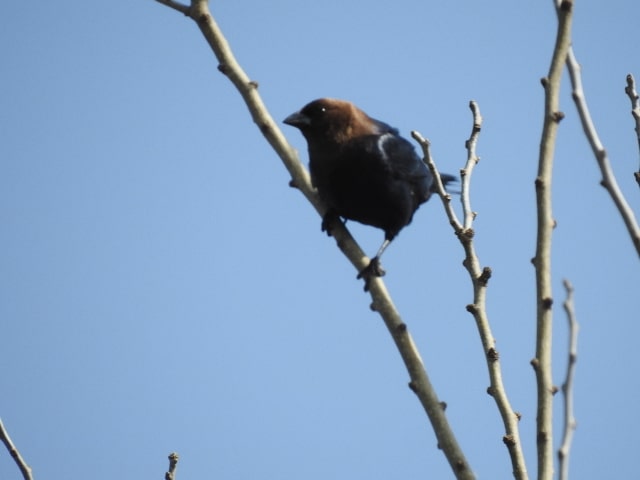
If the female cowbird finds her egg is missing, she may cause more problems, such as destroying more eggs.
Sometimes Cowbirds may remove an egg, lay their own eggs, and then pierce the remaining eggs.
Cardinals are unable to distinguish between their own and a cowbird egg or hatchling. The Cardinals will raise the Cowbird to self-reliance.
Aggressive at Protecting Territory?
Cardinals may protect a territory size of 1/2 to 6 acres during the breeding season.
With the average +/- 3 acres. Males will chase other males, and females will chase other females from the pair's territories.
Cardinals birds often fight with their reflection in house windows and car mirrors. To see what you can do about this behavior, check Cardinals Keep Flying into Windows.
What Do Cardinals Eat? Feeding
Diet in the Wild
In the wild, adult Cardinals eat a variety of foods consisting of insects, spiders, wild fruits, berries, and weed seeds.
In winter, their diet is more plant-based, which includes seeds and berries in the wild. Some insects under leaves may be found to supplement their diet.
Winter Diet: Favorite Seed and Best Feeder Type
When it comes to feeding Cardinals you need to offer the proper seed type and use an appropriate feeder style.
They can be attracted to winter bird feeding stations by offering their favorite seeds, Black-Oil Sunflower Seed and/or Safflower Seed.
Preferring to perch while eating at bird feeders, the best type of bird feeder for attracting Cardinals is the tray feeder types.
You can see what the seed types look like and learn more about them here: Favorite Wild Bird Seed Types.
You're likely to notice that these are often the first birds to arrive at the feeders in the morning and the last birds to eat in the evening.
Around my home, they make their last feeder visit at dusk.
Cardinals can be very territorial in their feeding habits during the breeding season.
If you want to see them at your bird feeders during Spring and Summer, try placing a couple of feeders out of sight from each other.
This will allow pairs to feed at the same time without all the chasing that happens.
One in your front yard and one in the back works well. In winter, Cardinals are more tolerant toward each other.
Do They Go South In Winter?
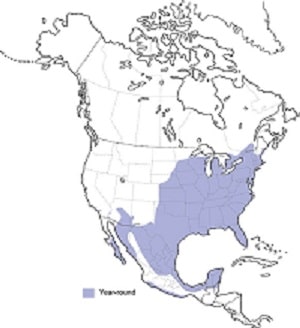
Northern Cardinals are permanent residents throughout their range and do not migrate south. Their range has been expanding further North.
If food and shelter are adequate, adult Cardinals will stay on their territories year-round1.
A Heated Birdbath can help provide the drinking and bathing water they need all year.
Where do They Spend the Night in Winter?
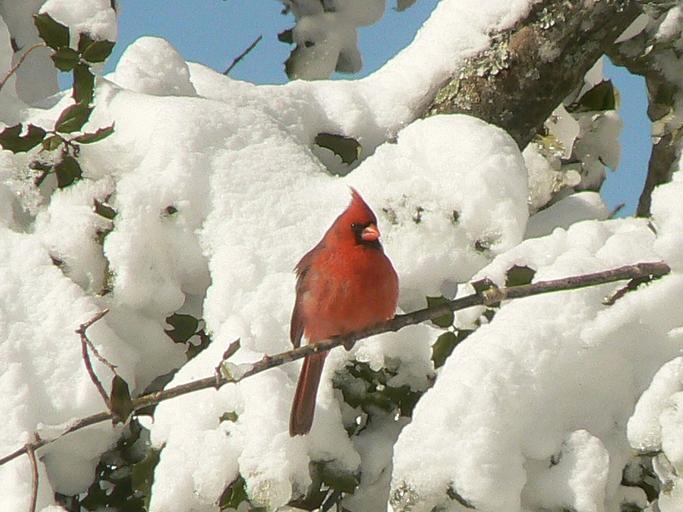
When it's time for a Cardinal to sleep at night, the bird will look for dense cover, especially in winter.
After their last trip to the bird feeder around dusk, they'll look for a thick stand of evergreen trees or shrubs.
These offer the best protection for wintry nights. The thick canopy above will help keep them dry.
They do not sleep in nest during winter and the male never sleeps in the nest during breeding season.
During the nesting season, the male will head for a roosting site where he is near the nest but not in the same tree or shrub.
Another way Cardinals can keep warm and sleep during winter is to fluff out their feathers to create air spaces that help insulate the bird and reduce heat loss.
For more on how birds get through the night, see: Where Do Birds Sleep?
I Saw a Bald Headed Cardinal
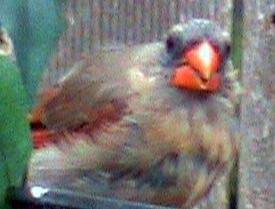
At some time you may see a male Cardinal that has no crest or head feathers at all. The bird looks bald.
This is not unusual and happens to many types of birds. The reason isn't known for sure.
Theories include parasite or dietary problems. The good news is, the condition isn't permanent and the bird will grow new feathers.
Predators
Known predators of adult Cardinals are Eastern Gray Squirrels,, Coopers Hawks, Cats, Dogs, and Loggerhead Shrike.
Nest site predators of eggs and nestlings include Blue Jays, snakes, squirrels, eastern chipmunks, opossums, and raccoons.
House Wrens have been known to pierce eggs in nests.
More Information
Does Arizona Have Cardinals? What is the gray bird that looks like a cardinal
Prevent Cardinals and Other Birds From Pecking and Crashing into Windows
See and Read About A Season We Had With This Bird - Video of Bird on Nest

